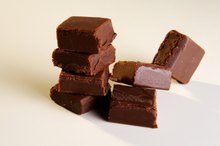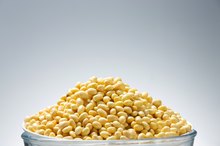Can Chocolate Cause Swelling in Joints?
It’s an odd event if after eating chocolate you suddenly realize that your joints are swollen, but there may be a connection. If you’re allergic to chocolate, you can develop joint swelling and pain in different parts of your body. If you notice that joint swelling is a common result from eating chocolate, stop consuming all products that contain chocolate until you can be evaluated by a medical doctor and an allergist. Most chocolate allergies cause mild to severe symptoms, varying from person to person.
If you are experiencing serious medical symptoms, seek emergency treatment immediately.
Chocolate Allergy
A genuine chocolate allergy is an immune reaction, or hypersensitivity, to cocoa. Cocoa is the main ingredient that makes chocolate products and is made from the seeds of the cocoa tree. The seeds are fermented, roasted and ground for use in cooking. Cocoa originated in Central America but is now grown in most tropical climates globally. In order for your condition to be considered an allergic reaction, your body must produce immunoglobulin E antibodies, or IgE. Antibodies are disease-fighting agents that typically fight off infectious organisms. Immunoglobulin E antibodies are only created during an allergic reaction.
- A genuine chocolate allergy is an immune reaction, or hypersensitivity, to cocoa.
- Cocoa is the main ingredient that makes chocolate products and is made from the seeds of the cocoa tree.
Joint Swelling
Can Chocolate Cause Nasal Congestion?
Learn More
Joint swelling from a chocolate allergy may show up hours after you’ve eaten the chocolate product. During an allergic reaction, the IgE antibodies trigger mast cells to produce histamine in soft tissues. Histamine is a normal chemical found in the body, but during an allergic reaction, excessive amounts cause problems. Histamine that is released in the soft tissues between your joints will cause inflammation and swelling. The excessive pressure that builds between the two bones of your joint will cause pain in that area.
- Joint swelling from a chocolate allergy may show up hours after you’ve eaten the chocolate product.
- Histamine that is released in the soft tissues between your joints will cause inflammation and swelling.
Consideration
While it is possible to have an allergy to cocoa, most cases of chocolate allergies are related to other ingredients in most chocolate products, such as:
- milk
- eggs
- soy
- peanuts
- tree nuts
These typical ingredients are considered some of the most common foods that cause allergic reactions. If you have a known food allergy, you need to read the label of every chocolate product before consuming it.
Treatment
Caffeine Sensitivity & Itching Skin
Learn More
Treating swelling in the joints from a chocolate allergy begins with undergoing allergy tests. Allergy tests involve injecting your skin with different suspected allergens, such as cocoa, milk and nut proteins. If your skin becomes inflamed and red, you are allergic to that substance. If diagnosed with a chocolate allergy, you will need to eliminate chocolate and any food that contains cocoa 1.
- Treating swelling in the joints from a chocolate allergy begins with undergoing allergy tests.
- Allergy tests involve injecting your skin with different suspected allergens, such as cocoa, milk and nut proteins.
Related Articles
References
- Center for Food Allergies: Arthritis: Inflammation With a Cause
- Camps-bossacoma M, Abril-gil M, Saldaña-ruiz S, Franch À, Pérez-cano FJ, Castell M. Cocoa Diet Prevents Antibody Synthesis and Modifies Lymph Node Composition and Functionality in a Rat Oral Sensitization Model. Nutrients. 2016;8(4):242. doi:10.3390/nu8040242
- Rodríguez-lagunas MJ, Vicente F, Pereira P, Castell M, Pérez-cano FJ. Relationship between Cocoa Intake and Healthy Status: A Pilot Study in University Students. Molecules. 2019;24(4). doi:10.3390/molecules24040812
- Rossini K, Noreña CP, Brandelli A. Changes in the color of white chocolate during storage: potential roles of lipid oxidation and non-enzymatic browning reactions. J Food Sci Technol. 2011;48(3):305-11. doi:10.1007/s13197-010-0207-x
- Nemours. Food allergies: how to cope. Reviewed September 2015
- McGee, Harold. On Food and Cooking: The Science and Lore of the Kitchen. "Chapter 12: Sugars, Chocolate, and Confectionary." Rev. Ed. New York: Scribner. 2004.
Writer Bio
Diane Marks started her writing career in 2010 and has been in health care administration for more than 30 years. She holds a registered nurse license from Citizens General Hospital School of Nursing, a Bachelor of Arts in health care education from California University of Pennsylvania and a Master of Science in health administration from the University of Pittsburgh.









